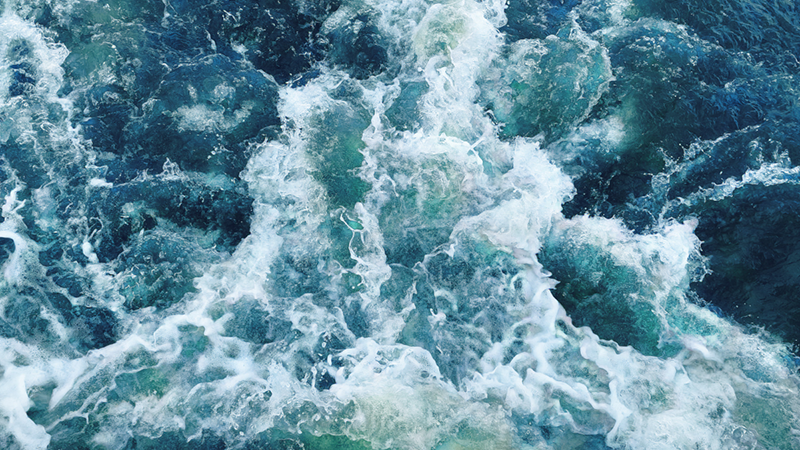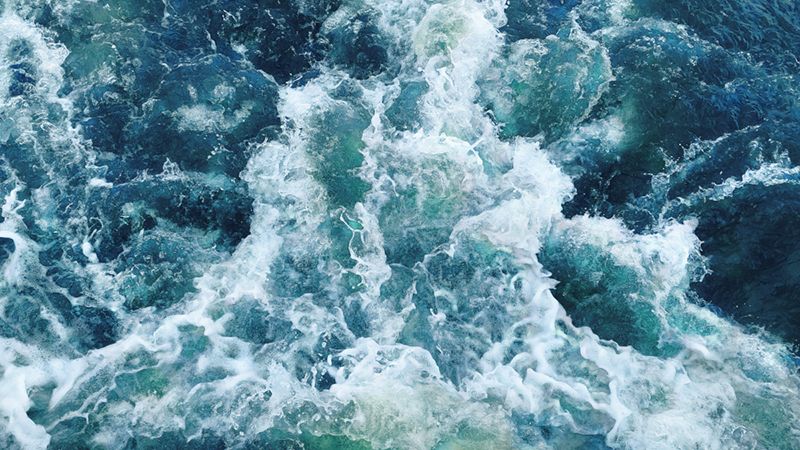Writing the Rules of Turbulence
Turbulent systems such as ocean waves and financial markets can be excited by blowing wind and world-shaking news, respectively, but the input energy often ends up at a different scale than where it was injected. Turbulence causes the energy to cascade from broad large-scale fluctuations down to tiny local ones, where it eventually dissipates as heat. By observing a turbulent cascade on all length scales in a quantum fluid, researchers at the University of Cambridge have uncovered a relationship between two key properties that describe the energy flow within the system [1]. The result illustrates that it is possible to provide an equation of state—a thermodynamic relation like the ideal-gas law—for systems that are far from equilibrium.
Capturing the properties of many-body systems, like the molecules in a gas, is the name of the game for equilibrium thermodynamics. Here, equations of state draw fundamental relationships between measured quantities that characterize the system’s macroscopic properties, without probing microscopic details. For example, Robert Boyle in 1662 observed that the volume of a gas, at constant temperature, is inversely proportional to its pressure. Researchers have long questioned whether similar analyses could be possible for fundamentally nonequilibrium systems, such as glassy materials, active matter, and turbulent fluids.
Nonequilibrium systems are difficult to characterize, since one cannot usually calculate expected behavior exactly from first principles, nor measure all the relevant quantities in a single system. Turbulent fluids, for example, have to be characterized over a wide range of scales, as energy injected into the fluid creates large waves that transfer energy into increasingly smaller waves until the tiniest eddies dissipate all the original energy. “Experimentally identifying general properties of such cascades is crucial for advancing our understanding of wave turbulence in both quantum and classical systems,” says Zoran Hadzibabic, who led the new work.
To establish a nonequilibrium system in which they could manipulate and examine turbulence at all length scales, Hadzibabic and his team used a quantum fluid, in particular, an ultracold gas made of potassium atoms. First, they trapped the atoms in a cylindrical “box” made of laser light. They then applied an oscillating magnetic field that agitated the contents of the box, like shaking a bathtub filled with water. This energy input initially created long-wavelength excitations in the gas, but over time, interactions between the atoms caused the excitations to cascade to ever-smaller length scales. Eventually the energy dissipated, and the energy cascade reached a stable state when the dissipation rate exactly matched the energy injection rate.
The researchers tracked the atom motion with high enough precision that they could measure the amplitudes of all the excitation modes, down to those with the shortest wavelengths in the energy cascade. “What’s important is that we can observe all the relevant length scales—this is very hard to do in other systems where turbulence occurs,” Hadzibabic explains. He and his colleagues found that the population of waves followed a power-law distribution characterized by an exponent and a spectrum amplitude (the power-law prefactor). This distribution remained unchanged because energy flows in a steady manner from large to small length scales.
Finally, the researchers measured the the energy flux, which is the amount of input energy that flows through the system and dissipates away. In a classical fluid like stirred-up bathtub water, the energy flux is difficult to determine, as the amount of stirring energy that flows through the system and dissipates away as heat is too small to make a measurable change in the bathwater’s temperature. In the team’s quantum gas, however, the dissipated energy can be measured precisely by counting the atoms that escaped the trap with a well-defined energy.
By repeating their measurements with different gas densities and shaking parameters, the researchers found that spectrum amplitude and energy flux could always be related by the same universal function. “Like equilibrium thermodynamics, it doesn’t matter how energy gets into the system; it just matters how much of it gets in,” says Hadzibabic. The measurements showed that a universal equation of state exists for this nonequilibrium system and describes a relationship that is fundamental to theories of turbulence.
“Theorists would expect some equation-of-state-like relation between the spectrum amplitude and the energy flux. But to see this experimentally is exciting,” says Hadzibabic. This universal equation of state can be cast in a dimensionless form, which means that length scales specific to the quantum system become irrelevant. The result could be more generally applicable to classical fluids, perhaps leading to a new tool for describing nonequilibrium systems. Still, models of classical wave turbulence do not fully capture the new quantum observations, so there may be differences yet to be understood.
Luca Sorriso-Valvo, a physicist at the Italian National Research Council’s Institute for Plasma Science and Technology whose work focuses on turbulence and space plasmas, says that the cold-atom-based approach could help researchers to describe dynamic regimes and the associated scaling laws in real-world turbulent systems. “The study of turbulent systems in the framework of far-of-equilibrium thermodynamics is a challenging and exciting topic,” he says. The new equation reveals fine-scale details of an energy cascade that may help to model complex turbulent flows.
–Rachel Berkowitz
Rachel Berkowitz is a Corresponding Editor for Physics Magazine based in Vancouver, Canada.
References
- L. H. Dogra et al., “Universal equation of state for wave turbulence in a quantum gas,” Nature 620, 521 (2023).





